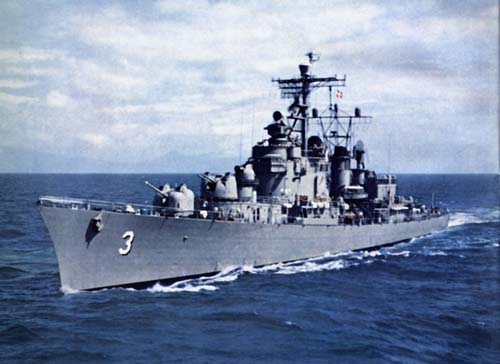
|
|
History of USS John S. McCain
She was named for John Sidney McCain. He was born in Teoc, Miss. 9 August 1884 and graduated from the Naval Academy in 1906. His first assignments were ships of the Asiatic Squadron. During the American occupation of Vera Cruz in the Mexican revolution he served in the San Diego. Between the World Wars, McCain served in many ships, including Maryland, New Mexico, and Nitro. His first command was Sirius. From 1937 to 1939 he commanded the carrier Ranger. In World War II he served as Commander of Air Forces for Western Sea Frontier and the South Pacific Force. In October 1942 McCain became Chief of the Bureau of Aeronautics and in August 1943 rose to the rank of Vice Admiral as Deputy Chief of Naval Operations (Air). In 1944 he command a fast carrier task force. Vice Admiral McCain died 6 September 1945, just after arriving back in the United States, and was later appointed Admiral effective that date. The ship was originally designated DD 928 but reclassified in 1951 as the USS John S. McCain (DL 3). She was launched by Bath Iron Works Corp., Bath, Maine, 12 July 1952, sponsored by Mrs. John S. McCain, Jr., daughter-in-law of Admiral McCain; and commissioned 12 October 1953 at Boston Naval Shipyard, with Comdr. E. R. King in command. She had a displacement of 3,675 tons, was 493 feet long with a beam width of 50 feet and a draft of 13 feet, 10 inches. She could make a speed of 30 knots and had a compliment of 403 officers and enlisted men. Her armament included two 5-inch and four 3-inch gunmounts, four 21 inch torpedo tubes, one ASROC, and one depth charge tract. She was of the Mitscher class. The first year of her commissioned service was spent undergoing sea trials and shakedown training in the Atlantic and Caribbean. Then she went to Norfolk on 19 May 1955 to begin service with the Operational Development Force in testing new equipment and tactics. She operated out of Norfolk until 5 November 1956, when she steamed from Hampton Roads bound for the Panama Canal and San Diego. After her arrival 4 December 1956 she spent 5 months on maneuvers in California waters. The frigate sailed for her first Far East cruise 11 April 1957, and after a visit to Australia, joined the Formosa Patrol, helping to prevent a military clash between Nationalist and Communist Chinese forces. She returned from this important duty to San Diego 29 September 1957. She steamed to her new homeport, Pearl Harbor, in early 1958, and took part in fleet maneuvers and antisubmarine training for the next 8 months. In early September the ship deployed to the Formosa-South China Sea area to help the 7th Fleet deter a possible Communist invasion of Quemoy and Matsu Islands. She remained in this critical region until returning to Pearl Harbor 1 March 1959. She made her third deployment to the Far East in the fall of 1959, departing 8 September and moving directly to the coast of troubled Laos. Here again the presence of American ships helped to stabilize the situation. During October, she was off Calcutta, India, carrying antibiotics and donating food and money to flood victims. In January 1960 the versatile ship rescued the entire 41-man crew of Japanese freighter Shinwa Maru during a storm in the South China Sea. Returning to Pearl Harbor 25 February, she began a period of overhaul and shipboard training. John S. McCain departed 7 March 1961 for another deployment with 7th Fleet, spending 6 months off Laos and Vietnam helping to thwart Communist designs on the strategic area. She resumed operations in Hawaiian waters after her return to Pearl Harbor 25 September 1961. When Russia resumed atmospheric nuclear testing some months later, the United States went ahead with plans for her own series of Pacific tests, and USS John S. McCain steamed to Johnston Island 27 April 1962 to take part in the experiments. For the next 6 months she operated between Hawaii and Johnston Island, departing for her next cruise to the Far East 28 November 1962. There she returned to patrol duties in the South China Sea and Gulf of Tonkin, buttressing the South Vietnamese government in its fight against the Viet Cong. She also took part in the Formosa Patrol in the Straits before returning to Pearl Harbor 16 June 1963. Anti-submarine warfare exercises followed, and the ship got underway again 23 March 1964 for operation with a hunter-killer group in Japanese and Philippine waters. During this cruise she took part in exercises with ships from other SEATO nations as well as units of the 7th Fleet. John S. McCain returned to Pearl Harbor 11 August. She operated in Hawaiian waters until the spring of 1965. She was reclassified DDG 36, 15 April and returned to the West Coast. In August the frigate returned to Pearl Harbor, and then sailed on a six-month deployment in the western Pacific. In the fall, John S. McCain steamed off South Vietnam. On 24 November she shelled Viet Cong positions. Two days later she sailed to Hong Kong and ended the year in Japan preparing for further action in the cause of peace and freedom. After further operations in the Orient early in 1966, John S. McCain returned to the East Coast and in June decommissioned for conversion into a guided missile destroyer, DDG 36, at the Philadelphia Naval Shipyard in Philadelphia, PA, where she remained until 1967. Submitted by Al Marquis, Historian
|
